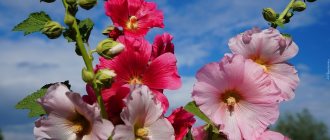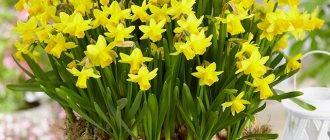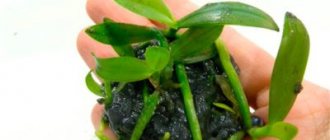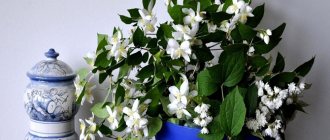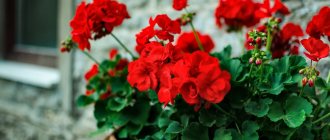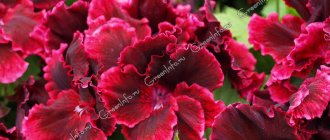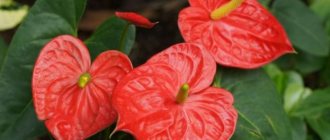Impatiens is a herbaceous flowering plant that is widely used to decorate balconies, flower beds and rock gardens, creating bright combinations with bells, begonia, fuchsia, ornamental grasses and other plants with summer flowering but moderate development.
Interesting Facts:
- The botanical name Impatiens is an allusion to the seed pods that, once ripe, open at the slightest touch.
- In the language of flowers, balsam is a symbol of masculinity and intelligence.
Botanical description
Garden balsam is a herbaceous flower, a representative of the Impatiens genus. If you translate this flower into Latin, you get “impatient.” As a rule, it blooms in summer until August, when the fruits appear. The fruit capsules curl when they bloom and small seeds fall to the ground. They jump out in different directions up to two meters in diameter.
Impatiens for garden plots is a poisonous plant ! This is worth considering if children often play on the ground and animals run around.
Lifespan
Garden balsam can live for two whole years and delight you in the garden in summer and in an indoor pot in winter. Proper care, watering and weather conditions are very important - these are the main components that affect the lifespan. You also need to remember that, after all, every season it is necessary to renew the balsam using cuttings, thus increasing the number of the plant.
transplant it into a pot before the onset of cold weather (September - October) and grow it at room temperature all winter. During frosts, most of the plants die because the ground freezes, so in this way you can extend the life of the flower.
Our experts have prepared materials for you about other equally beautiful varieties of balsam, including Terry, New Guinea, Camellia and Wallera.
History of origin
This flower was brought to Europe in the 16th century.
He lived in the tropical forests of Africa, on its eastern shores. The plant can also be found in India, England and Ukraine. At first, decorative varieties specially grown for pots were especially popular. Later, people became acquainted with street varieties of balsam, which took root on plots of land and received their local name - Wet Vanka. This name appeared due to observations of balsam. Flower growers have noticed that with high humidity, droplets of water form along the edges of the leaves. This liquid is secreted by the plant itself. Now balsam is very common throughout our homeland, especially in western and eastern Siberia.
Varieties, varieties
There are many types of this ornamental shrub. In addition to natural specimens, breeders have developed a large number of new hybrids. These include varieties: “Elizabeth”, “Camellia”, “Carmelita”. The New Guinea fire is very beautiful. It has erect, thick stems, large dark green leaves and bright peduncles up to 5 cm in size.
Such beauty can decorate a balcony, terrace and window. Therefore, growing becomes a pleasant hobby for lovers of balsam bouquets.
Roly weed, although a perennial species, is most often grown as an annual crop. He received this nickname due to the formation of sweetish droplets on the leaves.
Other gentle names are also known: “touch-me-not” - because of the capsules with seeds that shoot out when touching the stem; “light” - because of the multiple bright red, as if burning, petals.
The buds are in the form of double roses or flat, like saucers, consisting of several delicate petals, 4-6 cm in diameter. The color varies: from light pink, carmine, lilac to dark purple.
Appearance and characteristics
Garden balsam is very fragile . It has fibrous roots and a bright green, sometimes purple, spreading crown. Oblong leaves with small teeth, growing up to 10 cm long, make the plant beautiful even in the absence of flowers. The straight dark stem has many branches. Bright, predominantly red and yellow inflorescences, medium in size, have an irregular shape. A long nose forms in the middle of the flower.
Hybrid varieties have a wide variety of species and color palette. Today, experts represent about 400 species of this beautiful plant. There are dwarf species, and there are plants up to 120 cm in size.
Impatiens balsamic: description of the species
First of all, balsam is known as a perennial indoor flower. It has been readily planted in homes throughout Europe since the 14th century. In Russia, the fashion for indoor balsams arose much later - around the end of the 18th century.
In the twentieth century, thanks to the efforts of breeders, many varieties of balsam were developed that were suitable for growing in gardens and park areas.
Note! In the domestic climate, balsam grows as an annual bush.
Garden balsam is a well-branched subshrub, whose height is dictated by its species characteristics. There are varieties whose size does not exceed 0.25 m, and there are representatives of the genus with a bush height of more than 0.7 m.
The stems of the plant are smooth, densely covered with leaf blades. The leaves are arranged alternately, they are of a regular oval shape and can reach a length of 10 cm. Moreover, the edge of the leaves has pronounced teeth and a sharp tip.
Characteristic colors:
- green;
- bronze-violet.
Interesting! Depending on the variety, up to 50 attractive flowers can bloom on a bush at the same time.
The buds are formed at the base of the leaf blade; their shape, size and color depend entirely on the characteristics of the variety.
Thus, regular, semi-double and double corollas with an incredibly wide color palette were obtained. Only the blue and blue range of petals is inaccessible to touch-me-nots.
In countries with mild, warm climates, impatiens can take up to 11 consecutive months to bloom. In Russia, garden varieties are grown as annuals.
What is the difference between outdoor impatiens and indoor ones?
It is easy to distinguish garden balsam from its domestic relatives at first glance. No special knowledge required here. It grows outdoors and has a looser, almost transparent bush. This becomes especially noticeable if the plant is exposed to ultraviolet light. Garden varieties bloom predominantly in yellow shades, while indoor varieties have a huge variety of colors.
Street varieties are believed to have medicinal properties . Garden balsam is actively used in folk medicine and helps to cope with many ailments. The voluminous fleshy parts of the leaves contain ascorbic acid, many organic substances and flavonoids - substances of plant origin that have antioxidant properties. Domestic varieties do not have such features.
Another important difference between street balsam and home balsam is that the first flower is an annual. But its beauty and the lights of flowers scattered across the crown completely compensate for this shortcoming.
Types of balsams
Currently, more than 400 varieties of this plant are known. They can be either annual or perennial. Impatiens blooms luxuriantly and has different colored buds. The most popular types of balsam are:
Wallera is a bushy plant up to half a meter tall. Numerous hybrids have been bred on its basis. It has erect, succulent stems and delicate, wide, oval-shaped leaves of green or brownish color. The plant loves warmth and light, so you should choose an appropriate room for it.
New Guinea is a hybrid plant with large flowers of bright colors. This perennial plant can be grown in open ground and in pots as an indoor plant. Their leaves have bright, rich shades of green with yellow veins. The variety especially needs warmth and light, so you need to choose the sunny side of the room.
Kandy is a young variety, recently bred. The bush has stems up to half a meter long, from which petioles with leaves extend. The leaves are oblong in shape with a pointed tip, and come in various shades of green. It blooms profusely, the buds on high stalks have different colors. The flowers are soft and velvety to the touch.
These are only the main types of plants that are found in Russia among lovers of flower cultivation. They are unpretentious to grow, so the choice falls on them.
There are a huge number of varieties that are also grown in the country, but they require somewhat painstaking care, which not every novice gardener can do.
Varieties and photos of herbaceous plants
Of the 400 types of garden balsam, some varieties are especially popular.
Waller's flower
When flowering, Waller's balsam has almost no leaves visible, and the inflorescences cover almost the entire surface of the plant . The most common varieties of this type of garden balsam: Stardust, Kandy, Duet, Symphony.
Perennial hybrid: New Guinea
New Guinea balsam is a perennial hybrid resulting from the selection of certain species. So far there are no seeds of this plant species in our country. But it also has its own varieties: Java, Macarena, Mini Gini, Jungle Rain.
Non-ornamental plants of this species: Ferruginous, Common, Small-flowered, Balfour, Niamniam.
undersized
The low-growing type of balsam grows no higher than 15 cm . The dense collections of flowers are so abundant that they make the plant look like a single bouquet. It differs from its fellows in a rich variety of shapes and colors. Low-growing balsam blooms until the autumn frosts.
We invite you to familiarize yourself with other types and varieties of such a beautiful plant as balsam. We have prepared articles for you about wild, terry, ferruginous, ampelous balsam, as well as about the Tom Samb variety.
Reasons for the popularity of balsam in landscape design
This unique plant surprises with its variety of varieties; bushes ranging in size from 15 to 60 cm bloom throughout the growing season. The most decorative varieties have become a common attribute of suburban areas, park areas, and urban environments.
Garden balsam with two-tone flower color
Garden balsam flower photo with buds resembling roses is used for various purposes:
- decoration of courtyards;
- as a potted plant;
- as a tapeworm;
- for border planting;
- in panoramic flower arrangements;
- in small flower beds;
- in mixborders.
In flower beds, “impatiens” begin to produce buds in May and finish flowering when cold weather sets in.
If flowers are damaged by return frosts, do not rush to throw away the bush. After feeding and pruning, the “touch-me-not” will continue flowering.
Impatiens are often used in decoration as a monoculture. By combining dwarf varieties up to 15 cm high with tall bushes reaching 50–60 cm, you can get a tiered flower arrangement with long flowering. By planting flowers of different shades, they create floral picturesque pictures. Varieties with pubescent stems are used for spot vertical gardening. Flowers feel great in hanging pots, boxes, flowerpots, and containers.
The ability of balsam to withstand shading allows it to be used for decorating tree trunks.
More than 300 varieties of domestic and foreign selection are known. Wild varieties from various warm countries are used as mother plants. Ground cover and ampelous species of “Vanka mokrogo” with lanceolate and oval leaves of different shades from light green to dark marsh color or green with a burgundy tint have been bred.
Landscape designers value balsam for its unpretentiousness, good survival rate, and excellent seed germination.
Bushes transplanted into pots will delight you with buds until next spring. They can become sources of cuttings for vegetative propagation. Root the stems in water or moist soil, creating tropical conditions: high humidity and temperature.
Features of planting in open ground
If a gardener wants to plant balsam on a plot of land in the garden, he must know some rules for growing and caring for the plant. To do this, you need to choose a place where there are scattered rays of the sun and a lot of shade. Such a place may be under a large tree crown, near the western wall of the house. The best time for planting is early spring. When the frosts have already gone and the temperature does not drop below at least 5 degrees. Young plants may die at zero.
If a gardener plants several bushes at once, then the distance between them must be at least 35 cm. The crowns need space for normal growth and development.
After planting, it is better not to immediately add any fertilizers or fertilizing to the soil. The plant must adapt to the new conditions and after two weeks you can add some nutrients.
The best place for planting will be the lake shore of a garden pool. Or maybe there is some kind of spring or living open fountain on the site. The plant loves humidity. Such a place will be ideal for its growth.
Lighting and place of flower beds in the garden
The most suitable place to plant this beautiful plant will be a shaded area. Direct rays of the sun can destroy the flower . Ultraviolet light burns the leaves, leaving terrible burns on them. The moisture-loving plant dries out before our eyes. Allow some light by protecting tree branches or larger plants nearby. It’s good if there is a river or any other body of water nearby. This will simplify watering, because balsam needs it very often.
Soil requirements
The best option would be loose, moist and slightly acidic soil. To plant balsam, you need to prepare a mixture of sand, peat and humus. It will be good to add leaf soil. The top layer of soil should always contain moisture, this means that the plant needs to be watered thoroughly.
Growing from seeds
The method of growing from seeds is used when growing balsam for seedlings. Growing a flower from seeds is not too difficult, but the process will require some attention from the grower.
A huge selection of planting material is available in gardening and flower shops, but if you have your own flower bed, you can prepare the seeds yourself.
Note! Impatiens seeds, provided that the source of seed material is non-hybrid plant forms, can remain viable for up to 5 years.
Seed preparation
Impatiens seeds purchased in the store do not require additional processing, since manufacturers disinfect the planting material.
It is recommended to keep seeds collected independently for a short time in a weak solution of potassium permanganate for disinfection.
Soil and containers for seedlings
It is better to plant the seeds in small individual pots in order to disturb the root system of the sprouts as little as possible.
As a substrate, it is recommended to use a mixture made up of equal parts of turf soil, peat and coarse river sand.
Sowing seeds
The timing of planting seeds is at the end of February - beginning of March. Impatiens seeds do not need to be buried in the substrate; it is enough to place them on the surface and only lightly press them into the soil.
For successful germination, seeds require a lot of sunlight, so it is worth placing the crops in a well-lit place.
Growing seedlings
The crops are watered and covered with glass or cling film. The shelter is removed daily for ventilation, watering is carried out as needed. After emergence of seedlings, the shelter is completely removed.
If the seeds of impatiens were planted in a common container, then the appearance of the third leaf becomes a signal for picking seedlings into individual pots.
How to plant in open ground
When 6–7 leaves appear on the plants, it’s time to pinch the tops of the balsams to stimulate branching. The time for planting in the ground falls in the second half of May - the time when the threat of return frosts has completely disappeared.
Before planting in the ground (about two weeks), the sprouts begin to harden.
Impatiens look good in a group, but plantings should not be thickened. The step between planting holes should be at least 30 cm.
Choosing a planting site and soil
Impatiens is one of those plants that do well in light shade. Too open areas with direct scorching sunlight can negatively affect the decorative qualities of the plant, as it will lead to sunburn and curled leaves.
Regular garden soil is suitable for growing the crop. Before planting seedlings, the flowerbed must be dug up and loosened, removing weeds and stones.
Rules for caring for balsam bush
Garden balsam adapts perfectly to many conditions . Its care, in fact, consists only of abundant watering and removal of unwanted weeds that can survive the plant. In addition, regular weeding helps the soil remain loose and crumbly. This means that the root system breathes and develops perfectly. If summer days are particularly hot, watering should be done every evening. This needs to be done abundantly enough to thoroughly water the soil to a depth of 30-40 cm.
It is useful to fertilize balsam with substances rich in nitrogen and phosphorus. With a lack of these substances, the foliage becomes dull, the inflorescences become smaller, and various diseases appear.
Transfer
Over time, mature balsams grown in pots will require larger containers due to their rapid growth and significant root development. In areas with mild climates, flowers are usually replanted in the spring into a container slightly larger than the previous one. This will help prevent excessive development of the root system at the expense of the aboveground part. The plant should be replanted together with a ball of earth, and new fresh soil with a high content of organic matter should be added.
Common diseases and pests
Like any living plant, balsam also has its weaknesses and susceptibility to various parasites.
- Rot . These phytopathogenic fungi and bacteria affect balsam leaves if watering occurs too intensely and there is stagnation of water. Soil drainage will be the solution to this problem.
- Spider mite . It sucks the juice out of the plant and it withers in a matter of days. A soap solution that needs to be sprayed onto the flower from a spray bottle will help here. Chemical compounds are used only in extreme cases.
- Viruses . You can tell that a plant is infected with special viruses by the curling of its leaves. Yellow spots appear on the surface of the flower. The virus is usually caused by the presence of aphids. And it needs to be dealt with only with special chemical means.
Annual plants, such as balsam, are completely removed from the soil after flowering. This means that the chances of developing diseases and pests are minimized. This prevention will help avoid recurrence of infections in subsequent plantings.
There are also diseases that affect the plant . Here are some of the most common diseases.
- Leaves fall due to hypothermia or lack of light. The same problem can occur if the soil is too dry.
- The buds fall off because the soil was too dry or because the plant did not adapt properly during replanting.
- The stems are stretched due to lack of light.
- Weak flowering, sparse inflorescences, because there are not enough nutrients and fertilizing.
With proper care, this plant will not cause much trouble and will delight you with its health, beauty and splendor.
Rules and recommendations for planting seeds
Garden balsam is usually cultivated using cuttings and seedlings; planting and caring for the plant do not take much time. Seedlings are grown at home at a temperature of 18-24°C. Seeds are planted in March-April, depending on climatic conditions. The optimal soil for planting is neutral, with a pH of 5.5–6.8. Choose loose soil with good permeability and rich in humus. A 1:1 mixture of loam and humus with the addition of 1 part sand or vermiculite is recommended.
Germinated impatiens seeds
The first leaves on thin stalks
Seedlings after picking
Impatiens need to be sown without planting. The seeds are laid out on slightly flattened, moist soil. Spray from a spray bottle, cover with film, put in a warm place (up to +27°C) until sprouts appear.
A month after planting, the seedlings begin to be hardened off, accustoming the plants to open ground conditions. First, the pots are taken out for a couple of hours, then the time spent outside is gradually increased to a whole day.
Why doesn't it bloom?
It also happens that a seemingly healthy and beautiful plant, not susceptible to pests and without any signs of disease, does not bloom. This means that even with perfect care, something went wrong. It is important to find out the cause and eliminate it. The reasons may be a lack or excess of light, watering, microelements, temperature changes and much, much more. All this has already been said above, and if all the conditions are met, then there is one more spare tip on the topic of balsam flowering.
Impatiens need to be trimmed in time and old, overgrown and too large shoots removed. This is necessary for the formation of new fresh branches, which will begin to produce abundant flowering.
Growth control
For good growth, balsam seedlings need sunlight. The length of daylight should be at least 14 hours. If there is a lack of natural light in the morning, evening and in cloudy weather, you need to organize lighting using lamps.
The correct growth of balsam is also influenced by the temperature in the room where the greenhouse is located. After the first shoots appear, the container with seedlings should be moved to a bright but cool windowsill. The optimal temperature is 16–18 degrees.
4 common types of garden violets that will become an indispensable flowerbed decoration
If the conditions are not met, the seedlings will stretch, the stems will become thin and weak. The plant will “fall” under the weight of its own leaves.
Reproduction methods
There are two main ways to plant balsam.
Seeds
Seeds need to be collected when the fruits are ripe.- Plant seeds in shallow containers or boxes.
- Sprinkle a thin layer of soil on top and water.
- The container can be covered with film; such a greenhouse will allow the seedlings to germinate faster.
- It is better to place greenhouses in a dark and warm place.
- When the first shoots appear, you need to move the flower to a bright windowsill.
- Watering occurs frequently, but stagnation of water should not be allowed.
- After 20 days, the babies begin to be transplanted into separate pots. Disposable cups are perfect for this.
- The seedlings are fertilized and become stronger.
- The time has come to harden the plants and adapt them to environmental weather conditions. To do this, you need to take them outside more often to a shaded place with diffused rays of sun. It is better to return home at night.
- As soon as about 10 leaves appear on the seedlings, you can proceed to transplanting them onto garden soil.
- Pour water into the hole and root the balsam to the level of the first leaves.
Seeds sown in January will produce flowering bushes in May.
Bushes
- Dig up a finished bush 10-15 cm high. It is very important to leave a lot of soil on the roots so as not to break them too much.
- Pour water into a hole 20 cm deep and place the balsam on the bottom, carefully covering it with earth.
- In order for the bushes to take root as well and quickly as possible, a good option would be to take soil from the place from which they were moved. This soil needs to be mixed with the soil in the garden area. This will help avoid stress caused by sudden changes in soil composition.
Impatiens like earth that is slightly acidic . And such soil is produced by peat impurities.
Garden balsam combines a lot of beauty: beauty, benefits, healing properties. This flower will delight you all summer and will become a source of aesthetic pleasure for the whole family.
Selecting a container for sowing seeds
Any box, container, pot, bowl, plastic cups for yogurt or sour cream are suitable for planting balsam. The depth of the container can be 5–7 cm.
When planting several seeds in one box, its width should be sufficient for the free growth of young shoots. When sowing in separate containers, size practically does not matter; the seedlings will have to be picked in any case. The optimal volume is no more than 200 ml.
The most successful container for planting seedlings is considered to be a wide food container made of thin plastic with a lid. In such a bowl, the seeds do not need to be covered with film. The lid creates the desired greenhouse effect.
At the stage of preparing the container, it is important to disinfect it by washing it with a strong solution of potassium permanganate. This will help destroy mold and mildew spores and protect the balsam from infection by parasites.
How to properly care for balsam in summer
This plant can actively develop in the wild, but garden varieties and hybrids should be given attention. Only compliance with agricultural technology will allow you to achieve lush flowering.
Watering
In hot summers, flower beds require a lot of moisture. Not all types of balsam are drought-resistant, so you need to water the flower garden regularly, focusing on the surface layer of soil. But the procedure should not be abused, so as not to provoke waterlogging. It will lead to fungal infection of plants.
Weeding, loosening
To make it easier for the roots to breathe, after watering the soil is loosened to a depth of 1.5 cm. At the same time, weeds are weeded, taking away moisture and nutrients. Those who rarely appear at the dacha can replace this procedure by mulching the soil around the plants.
What to feed for abundant flowering
From the beginning of planting in a flowerbed and right up to autumn, balsam needs regular feeding. They are carried out 2 times a month, using a complex of weakly concentrated fertilizers. Starting from the moment of flowering, nitrogen-containing compounds are completely eliminated and “Impatiens” is transferred to a phosphorus-potassium diet.
Problems with seedlings and diseases
If the conditions for growing seedlings described above are violated, the summer resident will end up with diseased seedlings. They will be weak, overly elongated, with pale foliage. Such sprouts and inflorescences turn out small and inconspicuous.
Having noticed signs of improper development of seedlings, the situation can be corrected by adjusting the development regimes. But if poor care leads to illness, you will have to make more efforts:
- cool air and high humidity provoke gray rot; in this case, you will have to destroy all the seedlings;
- if the damage is minor, then only the diseased part of the plant can be cut off; the cut site is sprinkled with crushed charcoal, and the seedlings are treated with fungicides;
- If there are signs of powdery mildew, bacteriosis, or mosaic, balsam is sprayed with Bordeaux mixture.
To avoid the development of diseases, it is recommended to treat seedlings with insecticides for prevention.
Impatiens are also susceptible to attack by pests. Plants can be damaged even indoors. In each specific case, different methods of struggle are chosen:
- the appearance of pinkish spots on the leaves indicates the presence of spider mites; the affected balsam is treated with a soap solution;
- whiteflies will have to be combated with insecticides, treating the bushes once a week;
- Having noticed aphids, the plants and the soil under them are sprinkled with tobacco dust.
To prevent pests from encroaching on open flower beds, balsam should not be planted densely. A preventative measure in the fight against diseases and insects is timely thinning of the flower garden.
Growing Tips
In order for garden balsam to sprout on time, grow well and not get sick, it is necessary to take into account some nuances of growing the plant:
- The flower prefers slightly acidic soil.
- If you plan to grow the plant in a pot, you need to organize a 3 cm drainage layer of fine crushed stone at the bottom.
- If the air temperature at night is below 10 °C, it is better to wait to plant the plant in open ground, otherwise it will most likely die.
- Impatiens growing in the shade bloom sparingly and grow very elongated; 10-12 hours of daylight is considered ideal for it.
- The soil around the plant should not be allowed to dry out; the flower will slow down its growth and the flowers will begin to fall off.
- The quality of the cuttings is affected by the frequency of pruning the main stem.
- To spray balsam, it is recommended to choose a sprayer with the smallest drops.
- Garden balsam is successfully combined in joint plantings with such plants as: fuchsia, begonia, petunia,
There are more than 500 varieties of balsam (ferruginous, creeping, small-flowered, Waller's balsam, etc.), each variety is characterized by an individual shape and color. Due to its unpretentiousness and bright flowering, it is often used to decorate parks, flower beds and home areas.
Growing conditions: soil, temperature, lighting
Impatiens cultivation and care largely depend on temperature conditions, area illumination and soil quality.
- For a plant to grow and develop well, it needs sufficient humidity and good lighting. Impatiens belong to light-loving flowers, but still the best growth and flowering indicators are shown by representatives grown in partial shade lighting. It has a bad effect on the plant, and sometimes leads to death when grown in the shade.
- The soil around the balsam needs to be loosened from time to time, but not too deep. In the off-season (once every 14 days), the flower needs to be fed. During the winter flowering period, feeding the plant is also necessary, but this can be done once a month.
- The optimal temperature for growing balsam in summer and spring is from 22 to 25 ° C, subject to regular watering of the substrate and ventilation of the room.
